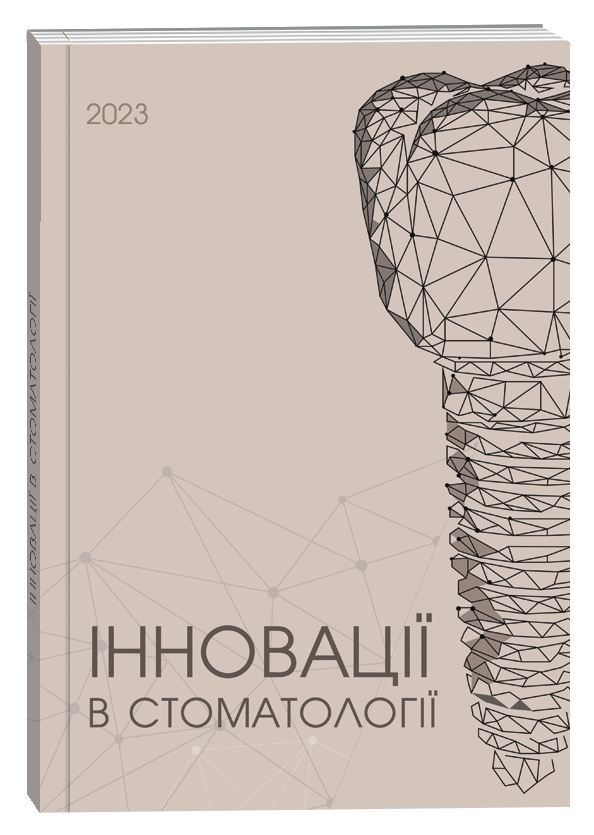MODIFIED METHOD OF DENTAL CROWDING TREATMENT DURING MIXED DENTITION
DOI:
https://doi.org/10.35220/2523-420X/2023.1.8Keywords:
malocclusion, mixed dentition, growth pattern, facial skeleton, palatal expansion techniqueAbstract
Introduction. Modern orthodontic literature database indicates a consistently high frequency of malocclusions and dentognathic deformities that appear in children and adolescents. A huge increase in their prevalence is observed in children during the mixed dentition stage, which reaches 80%. It is also scientifically proven that with age no selfregulation of dental crowding is observed and in 80-90% of all cases it’s likely to be observed during the permanent dentition period. Determination of facial skeleton growth pattern is of significant practical importance, as it allows to make the most optimal choice for treatment start, to choose correct treatment method, to predict treatment’s duration and consequences. Dental crowding is one of the most common issues of orthodontics nowadays. According to worldwide literature it’s prevalence reaches 77% and present at all occlusion periods, which is a significant sign of malocclusion’s severity. Literature describes many methods of dental crowding treatment during mixed dentition period, which is caused by both maxillary and mandibular constriction. The most modern one is usage of Rapid Maxillary Expansion protocol (RME) with Marco- Rosa appliance. While the advantages of this aplliance are well known and scientifically proven, this appliance doesn’t allow to directly expand maxillary frontal area and to create enough amount of space for anterior dental crowding regulation. That’s why a new appliance for dental crowding treatment during mixed dentition was suggested by us. It’s not only transversally expanding constricted maxilla but also equally expands maxillary frontal area (patent of Ukraine № 149170, 21.10.2021). Purpose of the study. Development of rational treatment protocol of patients with dental crowding during mixed dentition period according to facial skeleton growth patterns and also to make comparative analysis of treatment efficiency by using traditional and suggested protocol. Research methods. Patients in mixed dentition period with dental crowding (n=164) were examined over a period of last three years at the base of NMU O.O. Bogomolets Dental Center, Kyiv. A total of 328 CBCT sections of facial skeleton (medium FOV) before and after treatment were submitted to the general analysis. Scientific novelty. At the present stage, of interest is the effect of the newest concept of dental crowding treatment during mixed dentition according to facial skeleton growth’s pattern. Conclusions. Results indicated an improvement in treatment efficiency of this pathology and significant treatment time shortening. The results obtained after 16 months in patients with a horizontal growth pattern indicate that treatment efficiency value of clinical group (CG) II patients was 58.1±1.3%; after 17 months in patients with vertical and neutral growth patterns, treatment efficiency value of CG III was 66.7±1.6%, CG I – was 52.3±0.9%. The algorithm proposed by us allows to shorten treatment duration by 3-4 months.
References
Alhammadi, M. S., Halboub, E., Fayed, M. S., Labib, A., & El-Saaidi, C. (2018). Global distribution of malocclusion traits: A systematic review. Dental press journal of orthodontics, 23(6), 40.e1–40.e10. https://doi.org/10.1590/2177-6709.23.6.40.e1-10.onl
Дєньга, О. В. (2004). Поширеність зубощелепних аномалій і карієсу зубів у дітей у період раннього змінного прикусу. Український стоматологічний альманах, 1(2), 48-50.
Куроєдова, В. Д., & Дмитренко, М. І. (2008). Cкупченість зубів. http://repository.pdmu.edu.ua:8080/bitstream/123456789/6377/1/Crowding.pdf
Proffit, W. R., Fields, H. W., Larson, B., & Sarver, D. M. (2018). Contemporary orthodontics-e-book. Elsevier Health Sciences.
Ronay, V., Miner, R. M., Will, L. A., & Arai, K. (2008). Mandibular arch form: the relationship between dental and basal anatomy. American journal of orthodontics and dentofacial orthopedics : official publication of the American Association of Orthodontists, its constituent societies, and the American Board of Orthodontics, 134(3), 430–438. https://doi.org/10.1016/j.ajodo.2006.10.040
Sayin, M. O., & Türkkahraman, H. (2004). Factors contributing to mandibular anterior crowding in the early mixed dentition. The Angle orthodontist, 74(6), 754–758. https://doi.org/10.1043/0003-3219(2004)074<0754:FCTMAC>2.0.CO;2
Crossley, A. M., Campbell, P. M., Tadlock, L. P., Schneiderman, E., & Buschang, P. H. (2020). Is there a relationship between dental crowding and the size of the maxillary or mandibular apical base?. The Angle orthodontist, 90(2), 216–223. https://doi.org/10.2319/051019-324.1
Lombardo, G., Vena, F., Negri, P., Pagano, S., Barilotti, C., Paglia, L., Colombo, S., Orso, M., & Cianetti, S. (2020). Worldwide prevalence of malocclusion in the different stages of dentition: A systematic review and metaanalysis. European journal of paediatric dentistry, 21(2), 115–122. https://doi.org/10.23804/ejpd.2020.21.02.05
Caroccia, F., Moscagiuri, F., Falconio, L., Festa, F., & D'Attilio, M. (2020). Early Orthodontic Treatments of Unilateral Posterior Crossbite: A Systematic Review. Journal of clinical medicine, 10(1), 33. https://doi.org/10.3390/jcm10010033
Alsawaf, D. H., Almaasarani, S. G., Hajeer, M. Y., & Rajeh, N. (2022). The effectiveness of the early orthodontic correction of functional unilateral posterior crossbite in the mixed dentition period: a systematic review and meta-analysis. Progress in orthodontics, 23(1), 5. https://doi.org/10.1186/s40510-022-00398-4








